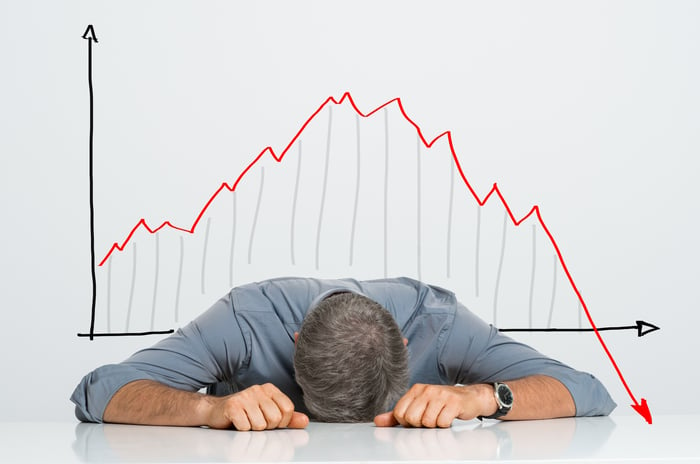Marijuana stocks are popular on Wall Street these days, with even giant international corporations attempting to stake out a claim in the space with big investments. But you don't have to own a stock that sells marijuana or a product that contains it (or its compounds) to get exposure to the massive growth expected in the sector. You could, instead, focus on companies that provide products and services to marijuana growers. One name that has been working hard to grow its presence as such a supplier is The Scotts Miracle-Gro Company (NYSE:SMG). Is it worth owning?
Picks and shovelsScotts is probably best known for lawn-care products like Miracle-Gro and Roundup. But those are just two of the company's products that help individual consumers and professionals alike maintain beautifully manicured landscapes. It's the company's core business, accounting for roughly 80% of sales in fiscal 2018.

Image source: Getty Images.
The thing about this segment is that it's not exactly a big growth opportunity. In fact, slow growth is likely the best that can be expected. For example, revenue on this side of the business actually fell 2% in fiscal 2018 because of sales weakness at Scotts' four largest retail store customers. Although the company doesn't report the fourth largest retailer to which it sells, the top three are Home Depot, Lowe's, and Wal-Mart, which together account for roughly 60% of sales. It's little wonder that soft sales at just a handful of names was enough take a toll, here.
This helps to explain why Scotts has decided that it wants a piece of the marijuana business. A little more diversification would be a good thing. In keeping with its roots, though, it hasn't invested in marijuana directly; it has built a sizable business selling hydroponic equipment. Hydroponics have long been used to grow marijuana, even before it was an increasingly legal thing to do. As the number of people growing pot expands, so too should the need for hydroponic equipment.
Very fast growthYear over year, the company's hydroponic sales grew 20% in fiscal 2018. That number was even more incredible in the fiscal first quarter of 2019, when sales growth was a massive 84%. For reference, lawn care saw growth of 9% in the first quarter, a good number, but nothing like what the company's hydroponic division, known as Hawthorne, experienced.
The problem is that the Hawthorne number isn't exactly a clean, apples-to-apples comparison, because Scotts has been using acquisitions to build its hydroponic business. That's clearly resulting in swift revenue growth, which should excite investors. But there's a downside to this approach, especially in an industry as hot as marijuana: price.

SMG Net Total Long Term Debt (Annual) data by YCharts.
Very quickly, Scotts has built its hydroponic business from, effectively, nothing to a roughly $600 million a year operation with some 1,800 retailer customers. It funded the acquisitions to get there with debt. Between fiscal 2014 and fiscal 2018, debt ballooned from $700 million (around 55% of the capital structure) to $1.9 billion (an unnerving 84% of the capital structure). At the end of the fiscal first quarter of 2019, long-term debt on the balance sheet had risen even further to nearly $2.2 billion -- nearly 90% of the capital structure.
Scotts is clearly spending heavily to grow its Hawthorne business and using a lot of leverage to do so. And it looks like it may have overpaid in the race to create a market-leading hydroponic business to serve the marijuana sector. For example, despite the heavy investment, Hawthorne is losing money (pull-out acquisitions and sales in the segment were down nearly 30% in fiscal 2018). Worse, Scotts took a one-time charge in the fourth quarter of nearly $95 million to write down the value of the Hawthorne investment (which reduced shareholder equity and, thus, increased its leverage even further). Sales growth was down 10% year over year in the fiscal first quarter of 2019, too, though management expects the segment to swing back to positive growth shortly.

SMG data by YCharts.
That said, management's comments on the division are less than inspiring. For example, during the fiscal first-quarter 2019 conference call, CEO Jim Hagedorn stated: "Let's be clear, I'm not claiming victory. We have a long way to go for that to happen, and we've learned the hard way that this industry has a lot of ups and downs." That sounds like Scotts rushed into a sector that it didn't fully understand on top of paying too much for the assets it bought (which is evidenced by the asset writedown). And even if Scotts manages to get the Hawthorne business moving in the right direction, it still has to deal with its heavily leveraged balance sheet.
Not worth the riskScotts may, in fact, be taking an intelligent risk by leveraging up to rapidly build its hydroponics business, but for most investors, the early signs aren't particularly encouraging. That helps explain why Wall Street punished the shares in 2018, sending them lower by 42%. You could argue that the beaten-down stock is starting to, perhaps, look a little cheap. However, that will only be true if the big bet it's made on hydroponics pays off and it can get its balance sheet back in order. That's more uncertainty than most investors should be taking on, especially when there are less risky ways to get exposure to the marijuana space.
No comments:
Post a Comment